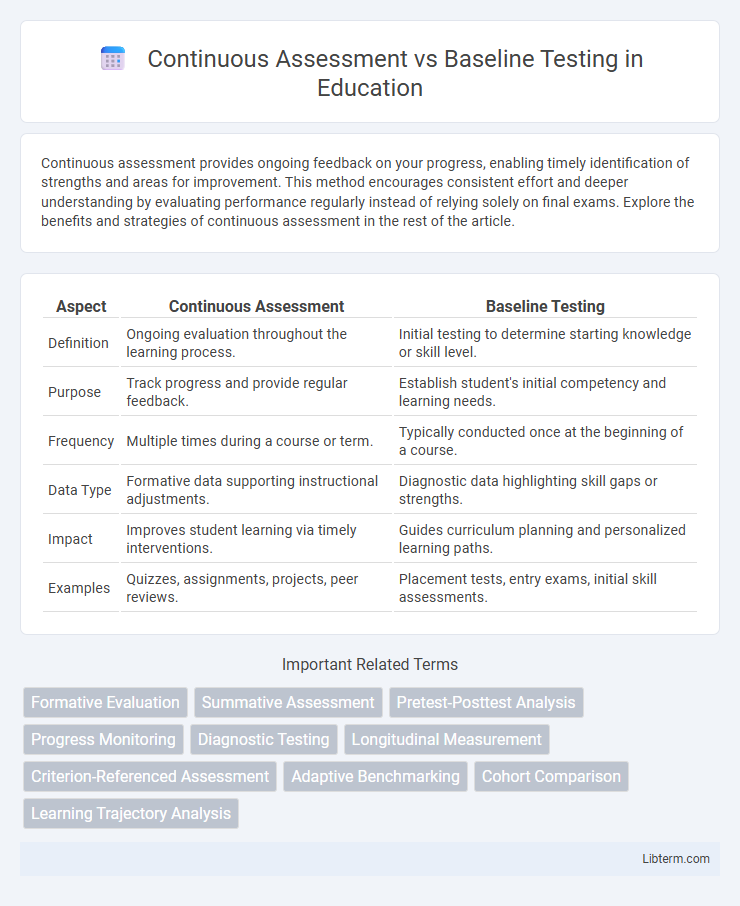Continuous assessment provides ongoing feedback on your progress, enabling timely identification of strengths and areas for improvement. This method encourages consistent effort and deeper understanding by evaluating performance regularly instead of relying solely on final exams. Explore the benefits and strategies of continuous assessment in the rest of the article.
Table of Comparison
| Aspect | Continuous Assessment | Baseline Testing |
|---|---|---|
| Definition | Ongoing evaluation throughout the learning process. | Initial testing to determine starting knowledge or skill level. |
| Purpose | Track progress and provide regular feedback. | Establish student's initial competency and learning needs. |
| Frequency | Multiple times during a course or term. | Typically conducted once at the beginning of a course. |
| Data Type | Formative data supporting instructional adjustments. | Diagnostic data highlighting skill gaps or strengths. |
| Impact | Improves student learning via timely interventions. | Guides curriculum planning and personalized learning paths. |
| Examples | Quizzes, assignments, projects, peer reviews. | Placement tests, entry exams, initial skill assessments. |
Introduction to Continuous Assessment and Baseline Testing
Continuous assessment involves ongoing evaluations throughout a course to monitor and improve student learning by providing regular feedback. Baseline testing occurs at the beginning of a learning period to measure students' initial knowledge and skills, establishing a reference point for future progress. Both methods are essential for tailoring educational strategies and ensuring accurate measurement of student development.
Defining Continuous Assessment
Continuous assessment involves the ongoing evaluation of student performance through various methods such as quizzes, assignments, projects, and participation, providing real-time insights into learning progress. This approach contrasts with baseline testing, which establishes an initial benchmark of student knowledge or skills at a single point in time. Continuous assessment enables educators to identify learning gaps and adjust instruction dynamically to improve student outcomes.
Understanding Baseline Testing
Baseline testing establishes a standardized point of reference by measuring initial performance or knowledge before any interventions or instruction. It provides critical data to identify strengths, weaknesses, and learning gaps, enabling tailored educational strategies. Understanding baseline testing is essential for accurately tracking student progress and evaluating the effectiveness of continuous assessment methods.
Key Differences Between Continuous Assessment and Baseline Testing
Continuous assessment involves ongoing evaluations throughout a course to monitor student progress and adapt instruction, while baseline testing is a one-time diagnostic test given at the beginning to establish initial knowledge levels. Continuous assessment uses multiple data points for real-time feedback, contrasting with baseline testing's single data snapshot for placement or entry-level analysis. The primary difference lies in temporal frequency and purpose: continuous assessment supports formative learning, whereas baseline testing serves as a summative starting reference.
Benefits of Continuous Assessment
Continuous assessment provides ongoing insights into student progress, enabling timely interventions and personalized learning strategies. It fosters skill development and critical thinking by encouraging regular engagement and feedback throughout the course. Unlike baseline testing, which offers a one-time snapshot, continuous assessment promotes consistent academic growth and better long-term retention.
Advantages of Baseline Testing
Baseline testing provides a critical reference point by establishing students' initial knowledge and skill levels, enabling educators to tailor instruction effectively. It identifies learning gaps early, facilitating targeted interventions that improve academic outcomes. Compared to continuous assessment, baseline testing offers a clear snapshot of starting performance, which is essential for measuring growth accurately over time.
Challenges of Implementing Continuous Assessment
Implementing continuous assessment faces challenges such as increased time and resource demands on educators, requiring consistent monitoring and timely feedback to maintain student engagement. Data management complexities arise from the need to track and analyze frequent assessment results accurately, potentially leading to inconsistent grading standards. Additionally, aligning continuous assessment with curriculum objectives while ensuring fairness and minimizing student anxiety remains a significant hurdle for educational institutions.
Limitations of Baseline Testing
Baseline testing provides a one-time snapshot of student performance, failing to capture ongoing progress or learning variability over time. It is limited in detecting subtle changes and trends, making it less effective for personalized instruction adjustments. This static nature can result in missed opportunities for timely intervention compared to continuous assessment methods.
Best Practices for Choosing an Assessment Method
Selecting the most effective assessment method hinges on the specific learning objectives and the context within which the evaluation takes place. Continuous assessment provides ongoing insights into student progress and adapts to individual learning needs, while baseline testing establishes initial skill levels to benchmark future growth. Best practices recommend combining both approaches to balance diagnostic accuracy with real-time feedback, ensuring a comprehensive understanding of learner development.
Conclusion: Selecting the Right Assessment Approach
Selecting the right assessment approach depends on the specific goals and context of the evaluation. Continuous assessment offers ongoing insights into learner progress and supports adaptive instruction, while baseline testing provides a clear snapshot of starting achievement levels for benchmarking purposes. Combining both methods can optimize data accuracy and instructional effectiveness for improved educational outcomes.
Continuous Assessment Infographic

 libterm.com
libterm.com